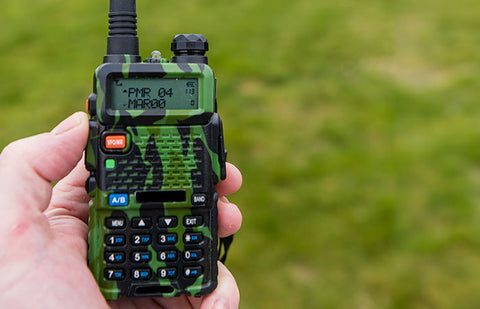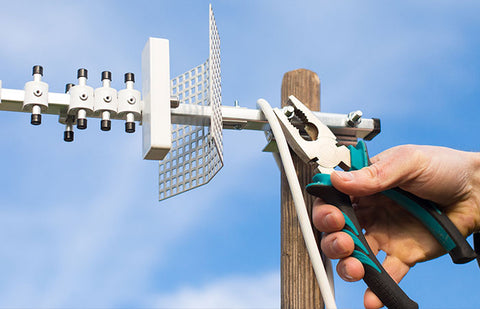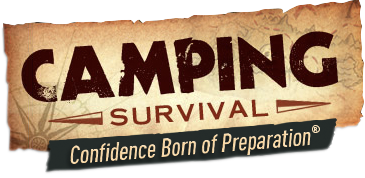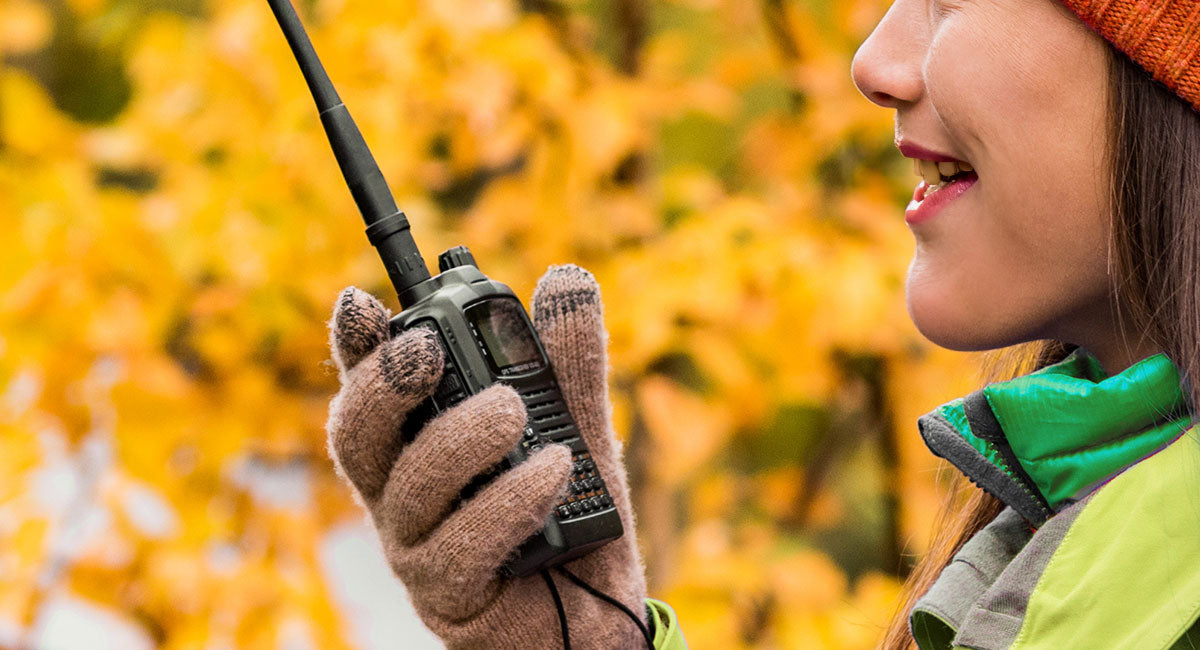Think you've covered all the bases in your survival strategy?
In the wild, beyond the reach of cell service and Wi-Fi, communication is your link to the world; and you’re going to need more than lights and smoke signals.
You need a bug-out location equipped with a survival ham radio kit, because it's not just about staying connected—it's about ensuring rescue and coordination when isolation becomes a threat.
Let's patch that hole in your survival game.
Building Your Ham Radio Kit
Building a reliable ham radio kit requires careful selection of components, each serving a critical role in ensuring clear, uninterrupted communication.
SELECTING A TRANSCEIVER
When choosing a transceiver, prioritize durability and portability without sacrificing performance. The Yaesu FT-60R and Kenwood TH-D74A stand out for their robustness, battery efficiency, and versatile frequency range, catering to both novice and experienced operators.
However, explore options like the Icom IC-705 for a more comprehensive feature set, including all-band operation and digital mode capabilities—ideal for field operations requiring broader communication reach.
Features to Consider – Look for transceivers with built-in GPS, weather-resistant construction, and the ability to operate across multiple bands and modes. Dual-band functionality (VHF/UHF) is a minimum, but all-band coverage is preferable for maximum flexibility.
Where to Purchase – Beyond electronics retailers and online marketplaces, consider ham radio swap meets, clubs, and forums where enthusiasts sell or trade well-maintained used equipment at a fraction of the cost.
Compatibility Check – Ensure the transceiver is compatible with additional modules or accessories you may want to add later, such as digital modems or external amplifiers, to enhance its capabilities.

POWER SOURCES
Your radio’s power source determines your operational longevity in the field. Solar panels like the Anker 21W are invaluable for their efficiency and portability, transforming sunlight into power without the bulk of traditional generators.
Pair solar charging with high-capacity rechargeable battery packs designed for ham radio use, ensuring a continuous power supply.
Battery Options – Consider lithium-ion or lithium-polymer batteries for a balance between weight and capacity. Brands like Bioenno Power offer models specifically designed for ham radio equipment, providing reliable power with minimal weight.
Solar Efficiency – When selecting solar panels, consider not just the wattage but also the conversion efficiency and compatibility with your charging setup. Look for panels with USB outputs for direct charging of devices and battery packs.
Power Management – Invest in a quality charge controller to protect your batteries from overcharging. A power distribution unit can help manage multiple charging sources and devices, ensuring efficient power use.
ANTENNAS
The right antenna can exponentially increase your transceiver's range and clarity.
While the Nagoya NA-771 is a solid choice for handheld operations, exploring antenna options like the roll-up J-pole for VHF/UHF or a multi-band portable HF antenna can provide versatility across different environments and needs.
DIY Antennas – Building a dipole or a ground-plane antenna can be a rewarding project, offering custom solutions for your specific setup. Utilize online resources or ham radio literature for designs and tuning methods.
Antenna Tuning – An antenna tuner is crucial, especially for HF operations. It can help optimize the performance of your antenna, particularly in makeshift or non-ideal setups, ensuring efficient signal transmission and reception.
Mounting Solutions – For field operations, consider lightweight, telescopic poles or suction mounts for vehicle deployment. This flexibility allows for quick setup and adjustment to local terrain and conditions.

PROTECTIVE GEAR
Securing your equipment against environmental threats is non-negotiable.
The Pelican 1200 Case offers excellent protection, but consider larger options like the Pelican 1450 if your kit expands. For backpacking, look for cases that offer both protection and portability with padded straps and lightweight, rugged construction.
Weatherproofing – Ensure that all external connections are sealed against moisture. Silicone grease can protect exposed connectors, while waterproof bags offer an additional layer of defense for non-waterproof items.
Impact Protection – Customizable foam inserts not only secure your gear in place, but also provide shock absorption from drops or vibrations. Regularly inspect and replace worn inserts to maintain protection.
ACCESSORIES
Completing your kit with the right accessories enhances both the functionality and enjoyment of your ham radio experience.
A quality SWR meter is essential for tuning your antenna, ensuring maximum efficiency and range.
For audio clarity, especially in noisy environments, a noise-canceling headset is invaluable. If you're proficient in CW operations, a portable Morse code key adds a layer of tradition to your communications.
Digital Interfaces – For operators interested in digital modes, a digital interface that connects your transceiver to a computer or smartphone can open up new avenues of communication, from email over radio to digital voice modes.
Power Accessories – A variety of cables, connectors, and adapters will ensure you can connect and power your devices in any configuration. Investing in high-quality, durable cables and connectors can save you from connectivity issues in critical moments.
ASSEMBLY
The assembly of your kit is the final step in merging all components into a cohesive unit.
Begin by methodically connecting your transceiver to the power source, checking for secure and clean connections to prevent power loss or damage.
Attaching your antenna comes next, with careful consideration of its placement for optimal signal transmission.
Finally, organizing your case not only protects your equipment but also ensures quick and easy access to all parts of your kit when you need them.
Using Your Field Communication Kit
Now that you're equipped, let's turn to the art of making contact and ensuring your messages travel far and wide.
ESTABLISHING COMMUNICATION
SOS Signals – Beyond basic Morse code, practice sending distress signals in various formats—voice, Morse, and digital modes—to ensure you can effectively communicate an emergency across different platforms. Conduct mock drills to simulate emergency scenarios, timing your speed and accuracy in sending these critical signals.
Navigating Frequencies – Develop a comprehensive understanding of the radio spectrum, focusing on the segments most relevant to survival communication. Create a frequency guide tailored to your geographic area, including international distress frequencies, local repeater frequencies, and frequencies commonly used by other survivalists and emergency responders. Regularly practice manual tuning and programming your radio to these frequencies to reduce setup time during an emergency.
Digital Modes – Invest time in setting up and testing various digital communication setups, including portable digital interfaces that connect your radio to a smartphone or laptop. Explore apps and software that facilitate text and data transmission over ham radio, practicing with real-world scenarios to ensure you can send detailed messages, maps, or even GPS coordinates when necessary.

STRATEGIC DEPLOYMENT
High Ground – Understand the principles of radio wave propagation and how environmental factors such as foliage, terrain, and buildings can impact your signal. Research and map out high-ground positions in areas you frequently traverse, planning potential communication points in advance.
Improvised Antennas – Deepen your knowledge of antenna theory, learning about different types of antennas and their specific use cases. Experiment with building various improvised antennas—such as long wires, loops, and verticals—using everyday materials. Test these antennas in different environments to understand their effectiveness and limitations.
Signal Boosting – In addition to utilizing repeaters, explore the use of RF amplifiers to increase your transmission power when legally permissible. Understand the balance between power, battery life, and signal range, optimizing your setup for the most efficient use of energy while maximizing communication reach.
Advanced Ham Radio Techniques for Survival
With the basics mastered, advancing your skills ensures you're prepared for any communication challenge.
SOLAR AND METEOR SCATTER COMMUNICATIONS
Utilize Solar Power – Deep dive into solar power systems, understanding the nuances of panel types, charge controllers, and battery storage options. Conduct experiments to find the most efficient configurations for your specific equipment, considering factors like weight, portability, and energy output.
Meteor Scatter – Engage with the ham radio community to learn from experienced operators who specialize in meteor scatter communications. Participate in scheduled meteor scatter events to gain hands-on experience, using specialized software to predict meteor showers and enhance your chances of successful communication.
NVIS (NEAR VERTICAL INCIDENCE SKYWAVE) FOR REGIONAL CONTACTS
Understanding NVIS – Expand your practical knowledge of NVIS by building and testing various NVIS antenna designs. Study the impact of the ionosphere's condition on NVIS propagation, learning to adjust your operations based on time of day, season, and solar activity. Organize or participate in NVIS communication drills with fellow ham operators to refine your skills.
ENCRYPTION AND SECURITY
Secure Channels – While maintaining legal compliance, explore techniques for obfuscating sensitive information. This can include developing a personal code system for communicating with trusted individuals or utilizing non-standard communication protocols that offer a layer of security.
Staying in the Know
Stay informed about the latest regulations and ethical considerations in ham radio operations to ensure your practices are both legal and responsible.
By doubling down on these advanced techniques and strategies, you significantly bolster your communication capabilities in survival situations. This deep dive not only prepares you for a wide array of challenges, but also integrates you more fully into the global community of ham radio operators, a vital resource in times of need.


2 comments
Good and interesting information. A couple of points; To be legal transmit on Amateur Radio Frequencies (or any frequencies) a person must have an FCC LICENSE! Classes and test sessions (very easy, no more Morse Code) check https://www.arrl.org/licensing-education-training
Learn how to interact with other Hams, use repeaters, check in to or create Radio Nets, and other Tips and Tricks… Join a local club. https://www.arrl.org/get-involved You’re likely to find out you are surrounded by other Ham Radio Enthusiasts, and the ton of information they have to share.
73 DE N4QPM
But don’t forget that you need to take a test for a license to operate ham radios.